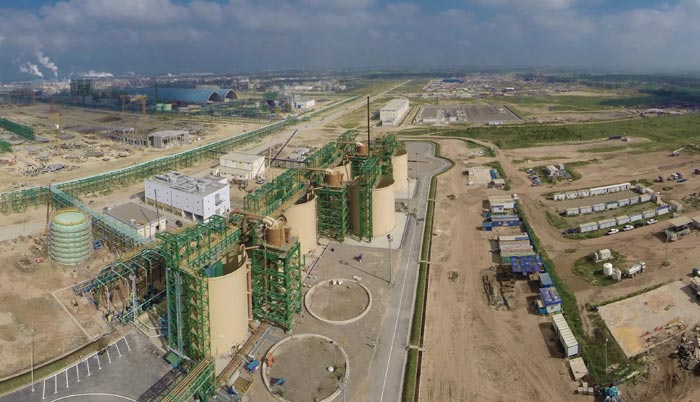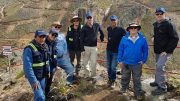MARRAKESH, MOROCCO — It’s hard not to be struck by the juxtaposition of tradition and progress when sitting in the back of a worn taxi cab winding its way through the maze-like confines of the medina quarter in the high-profile tourist destination of Marrakesh, Morocco.
The sprawling, walled-off section of the city is an anachronistic call to the Berber markets and nomadic trading centres of the past, though it is now populated by European tour buses and flashy sports cars, en route to modern shopping malls and golf resorts.
The medina is in many ways a microcosm of Morocco, with its clashes between the old ways and industrialism, the resulting political fallout.
But make no mistake: the big money in the North African nation is in phosphate rock, which is why its state-owned fertilizer entity — Office Chérifien des Phosphates Group (OCP) — hosts a major conference every two years called the International Symposium on Innovation and Technology in the Phosphate Industry, or Symphos.
There are a few things that stand out at the conference. First, OCP has a monopoly on the phosphate business in Morocco, so there are virtually no representatives from international fertilizer competitors, junior exploration companies or major financial institutions. Most of the corporate attendees are supply-chain outfits that either have contracts with OCP, or want a relationship.
Second, since OCP is not publicly listed, it has no requirement to disclose much about its business. So discussions about mining operations, financial results and capital projects are scarce. The company’s management is in a way guarded at the event, and seems more willing to talk about technological innovation and sustainable farming than its business unit.
“One of the focuses here is on the science of the industry, and the growing demand in Africa,” OCP of research and development director Rachid Boulif said on the floor of the conference. “We have many attendees and speakers from high-level technical committees, and we’re interested in contributions on new fertilizer products, by-product innovations and regional population growths and product demand.”
OCP reported revenues over the first half of 2015 totalling US$2.5 billion, with second-quarter adjusted earnings pegged at US$479 million. The company offset a temporary decline in Brazilian imports by almost doubling its sales within Africa.
Boulif highlighted that OCP is in the middle of a US$20-billion-plus expansion to double mining output and triple fertilizer production, and increase domestic demand.
The company will assemble African producers of raw materials and feedstock, and circumvent the historic presence of Western companies in the value-add chain. Phosphates from Morocco, along with resources from other African countries, could make fertilizers at a “more affordable price for local farmers.”
Part of the regional expansion includes a $600-million facility at Jorf Lasfar, which lies an hour drive south of the industrial city of Casablanca. The strategy is to give the company an operational hub on the coast for better access to African fertilizer markets.
Internationally, the supply and demand dynamic for phosphate and related fertilizers is dominated by a few major companies and developing nations.
OCP previously sold 1.5 million tonnes of fertilizer per quarter, but has brought another 1 million tonnes of capacity online, and aims to crank out 2 million tonnes next year. The company said on its quarterly conference call that fertilizer production will hit 10 million tonnes in 2017, which would make it the world’s top producer.
BMO Capital Markets analyst Joel Jackson, who directs fertilizer and chemicals research, said “the problem is that China accounts for a lot of the world’s phosphate production, though much of it stays ‘in house.’ There’s a lot of global trade, but the big markets are places like India — which accounts for anywhere from 30–50% of anything phosphate-related, in terms of trade and imports — and Brazil.”
With respect to exports, Jackson said, “you see most coming out of China, Florida and Morocco. India has a lot of domestic production as well, but they lack sources of phosphate rock, so they are both competitors and customers of the Moroccan and North American suppliers. It’s a bit of a strange dynamic, and the marginal costs of production, or where prices fall, is the Indian non-integrated cost curve. How much does it cost India to make phosphate fertilizer by importing all the raw material?”
Phosphate rock prices sat at US$115 per tonne in August, which is a big drop from the US$440-per-tonne level seen in 2008.
The nature of fertilizer production means that most of the major mining centres are near shipping ports, so that ammonia and sulphur can be imported for upgrading phosphate rock. Morocco simply owns the most product — as well as the highest-quality rock.
Because it’s expensive to develop integrated fertilizer processing centres, some North American companies have relied on importing Morocco’s phosphate rock. For example, Western Sahara Resource Watch reported that Canada’s Agrium (TSX: AGU; NYSE: AGU) was the largest importer from OCP’s PhosBoucraa mine in 2014, when it shipped over 779,000 tonnes of the material.
The practice is viewed as suspect by certain international organizations, since parts of the West Sahara claim independence from Morocco — such as the indigenous Sahrawis population. U.S.-based Mosaic (NYSE: MOS) stopped importing Morocco’s phosphate rock five years ago due to sociopolitical concerns.
Boulif did not comment on any underlying social issues, but said OCP is committed to sustainable and responsible growth in Africa.
OCP CEO Mostafa Terrab said in the company’s quarterly conference call that it believes the global phosphate market is poised for an “upswing” due to fundamentals that should counter “market volatility.”
Jackson points to the “down part of the cycle,” which is “marked by a global commodity malaise … and weak currencies, lower demand for a lot of nutrients and an oversupplied fertilizer dynamic.
“Prices really spiked over the past decade, which triggered a big expansion in capacity to the point that we’re now outstripping demand. So there’s a threat of disruption in the current markets. You saw Potash Corp. of Saskatchewan (TSX: POT; NYSE: POT) try to acquire K+S in a bid to control certain emerging supply centres … a lot of the mergers and acquisitions activity has been driven by a tough market with tough macro conditions, and some of the larger industry leaders are trying to control new supply,” he added.
Despite phosphate’s domination by big players, there are a few smaller companies with projects in the Americas. Stonegate Agricom (TSX: ST; US-OTC: SNRCF) is attempting to permit its Paris Hills phosphate project in Idaho, though its share price is down 87% year-on-year to 2¢ per share.
In Quebec, Arianne Phosphate (TSXV: DAN; US-OTC: DRRSF) is hoping to finance development at its Lac à Paul phosphate rock project in the Saguenay–Lac-St-Jean region. The company is one of the more promising stories in the junior fertilizer space, with shares up 58% this year en route to an 84¢ close at press time.
Meanwhile, Vancouver-based Focus Ventures (TSXV: FCV) is tackling the market from a different angle at its Bayovar 12 project, 80 km south of Piura, Peru. The company is looking at a small-scale development based on producing phosphate rock concentrate as direct-application fertilizer.
“We’re looking at a highly reactive rock that won’t require grinding or flotation, since under Brazilian export classifications, it is natural rock phosphate,” president and director David Cass said during an interview.
“It’s a relatively small part of the larger market picture, best for perennial crops that grow over multiple years, like palm trees. That’s because it has a steady, slow-release profile. It tends to be something that’s produced locally and sold locally, and because it’s an organic product, it appeals to more of a niche market,” he added.
“What we’ve learned is that its real value is in reinvigorating the nutrient richness in soils. In that way it’s sort of an investment in the ground, because it isn’t just ‘one hit’ like liquid fertilizers, so you get an incremental buildup in nutrient value in soils,” Cass continued.
Jackson is more skeptical about phosphate developments, arguing the world “isn’t short on phosphate rock.” He notes there have been projects in the works for a decade, but capital barriers and product concerns have kept production relatively reserved for the major players.
And based on the luxurious surroundings of Symphos, it’s clear that OCP is flush in cash. A conference attendee representing a major European integrated engineering firm, who requested anonymity, said Morocco well earns the moniker, the “Saudia Arabia of phosphate.”
But the plush, air-conditioned interior of the conference halls still seem at odds with the rustic earthwork walls of the medina quarter, and the fact that many Moroccan farmers can’t afford the fertilizers that drive so much domestic wealth.






Dear Matthew,
On behalf of the Western Saharawi community who administer the WS territory since 1975, I would like to share with you some points :
1. Morocco is not getting rich from the Western Sahara Territory. This is only about propaganda by algerian sponsored NGOs.
2. Western Sahara reserves of phosphates represent <2% (abt 1,6%) of national reserves.
3. WSRW is an NGO sponsored by Algeria to attack Morocco progress including the Western Sahara Territory.
4. WSRW talks on behalf of Algeria and not native Western Saharawi.
5. WSRW propagate for the account of Algeria that the Western Sahara Territory is a rich area and aslo Morocco is plundering its resources. This is not true. WS is a poor territory and Saharawi community is working to make it better thanks to central government efforts and international investments.
6. Algeria funds WSRW activities since more than a decade to propagate lies and fallacies on our daily life.
7. The Western Saharawi are sovereign in their land and are free to participate to the worldwide economy.
8. The Western Saharawi struggle to end the absurd issue facing Morocco and Algeria since cold war to make more progress.
9. In the meantime, the Western Saharawi welcome all international companies and SWFs to invest in motherland.
10. The Western Saharawi have been working since 2007 to implement autonomy as the ultimate solution to the abusrd issue in order to end the interfering of Algeria in our internal affairs.
...
Best Regards
Ahmed Salem Amr Khaddad
Unionist Western Saharawi - Internet Activist
A fine, incisive article, one deserving of wide reading.
Canada enjoys an interesting connection to Western Sahara through the purchase of high quality phosphate mineral rock from that territory by Agrium Inc. and Potash Corporation. In recent years, the two companies have accounted for the majority of the 2.2 million tonnes annually exported from Western Sahara; Agrium transporting it to Vancouver through the Panama Canal and Potash Corp. to Geismar on the Mississippi River.
Most of Western Sahara, known as Spanish Sahara until 1975, remains illegally occupied by Morocco. Much has gone into the manufacturing of a claim to the territory and so it must be recalled that the International Court of Justice concluded in its October 1975 advisory opinion that Morocco had no basis for a territorial claim. (See paragraph 162 of the decision, online at: http://www.icj-cij.org)
Moreover, many resolutions of the UN General Assembly have declared Western Sahara to be occupied (a term with particular import in international law), Spanish criminal magistrates are presently investigating war crime and genocide allegations under the occupation, and the African Union has recently (27 March 2015 and 14 October 2015) demanded the Saharawi people be permitted to exercise their right of self-determination as Africa’s last colony. That right, well settled in international law and practice (for which see the recent cases of Namibia and East Timor) includes the option of independence, something not on offer in a so-called autonomy proposal advanced by Morocco in 2007.
It is said that ‘on the internet, no one knows you’re a dog.’ So responsive posts are usefully treated with a degree of incredulity. Readers wanting useful, independent information about the problem of phosphate exports from occupied Western Sahara will find the October issue of the academic, peer reviewed journal ‘Global Peace, Change and Security’ useful, as well as reports of the Robert F. Kennedy Centre in Washington.
Professor Jeffrey Smith
Ottawa
this article is mainly about phosphate but the comment goes astray,because it focuses on a small branch of the big phosphate mining .However,the so-called western sahara phosphate total output is not sufficient to feed half population there.Kingdom of Morocco is spending a huge amount of her wealth modernising this part of Morocco,which wasn’t “terra nullius”with allegiance ties with all sultans or rulers of the cherifian kingdom of Morocco during 14 centuries,according to the famous decision of the ICJ on the matter.
By the way, the moroccan Sahara conflict was the result of the cold war that fainted after the collapse of wall of Berlin and is not a colonised territory and the greed of Algeria to have a window on the Atlantic ocean .It was freed due to The Green March which the whole Morocco will celebrate its 40th anniversary on November 6 .You are welcome to visit our southern territories and contemplate the progress carried out by Morocco so far;surely you will realise the differences between 1975’s situation and 2015’s nowadays achievements.Wish you good holydays ,Professor.
Abdallah RECHAG
Teacher and academic journalist
Casablanca,Morocco
this article is mainly about phosphate but the comment goes astray,because it focuses on a small branch of the big phosphate mining .However,the so-called western sahara phosphate total output is not sufficient to feed half population there.Kingdom of Morocco is spending a huge amount of her wealth modernising this part of Morocco,which wasn’t “terra nullius”with allegiance ties with all sultans or rulers of the cherifian kingdom of Morocco during 14 centuries,according to the famous decision of the ICJ on the matter.
By the way, the moroccan Sahara conflict was the result of the cold war that fainted after the collapse of wall of Berlin and is not a colonised territory and the greed of Algeria to have a window on the Atlantic ocean .It was freed due to The Green March which the whole Morocco will celebrate its 40th anniversary on November 6 .You are welcome to visit our southern territories and contemplate the progress carried out by Morocco so far;surely you will realise the differences between 1975’s situation and 2015’s nowadays achievements.Wish you good holydays ,Professor.
Abdallah RECHAG
Teacher and academic journalist
Casablanca,Morocco
Western Sahara!!!!
That’s a myth! A mere tentacle used by neighbouring Algeria to interfere in Moroccan affairs in order to weaken us.
Western Sahara is part and parcel of Morocco, and will remain so till the end of mankind.
One more thing: the ancient walls of Marrakech the writer seems to look down upon are a precious part of our heritage, are centuries old and cost a lot of money to preserve. Knowledgeable people from all over the world know what they are worth.